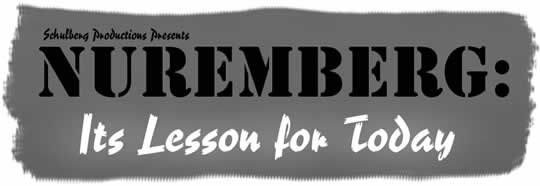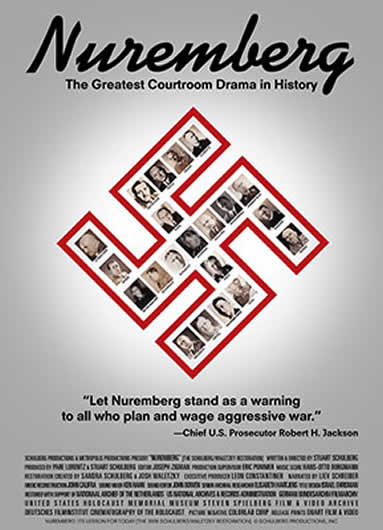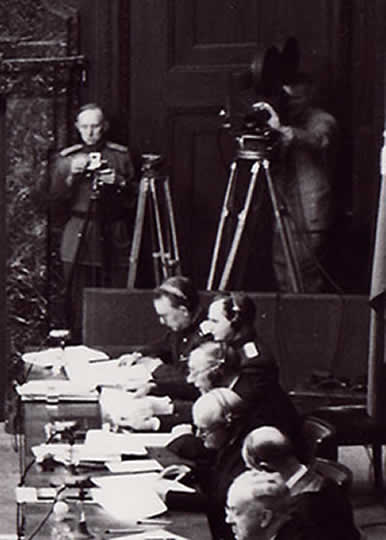 The War Crime trials at Nuremberg set the precedent, introduced a radical principle into international law. It defined the notion of a War Crime, holding individuals (political, military and industrial leaders) responsible for murder and “Crimes against Humanity” in the context or waging an aggressive war.
The War Crime trials at Nuremberg set the precedent, introduced a radical principle into international law. It defined the notion of a War Crime, holding individuals (political, military and industrial leaders) responsible for murder and “Crimes against Humanity” in the context or waging an aggressive war.
Commissioned by the U.S. War Department, “Nuremberg: Its Lesson For Today was written and directed in 1948 by Stuart Schulberg, a veteran of the John Ford’s Office of Strategic Services (OSS) Field Photographic Branch/War Crimes Unit, charged, in 1945, with locating Nazi film evidence to be shown in the courtroom at Nuremberg.
Stuart’s older brother, Budd (another senior officer in the unit) was a member of the team of writers and editors who assembled the original materials used in the documentaries “Concentration Camp ” and “The Nazi Plan”, used as prime evidence against the 24 Nazi War Criminals.
Ford’s OSS unit was also asked to film the Trial, but they were so busy assembling footage to show at the Trial, that they had to decline.
After the trials, during the denazification period, Shulberg was again commissioned to make a documentary using the Nazi footage. Schulberg, Pare Lorentz (“The Plough That Broke the Plains”, “The River’) and editor Joseph Zigman, were limited, as the Army Signal Corps cameramen and still photographers, who filmed the Trial, shot only 25 hours of a trial which lasted 10½ months.
Conceived as a lesson for future generations, the longer film contained footage of the trial as well as the evidentiary films they originally compiled.
It is the ultimate courtroom drama, more riveting than any fiction or recreation could ever be. Raw and harrowing, even though we already know the facts displayed. What’s more, it’s a paean to the scrupulous detailed nature of the trials themselves, an example of the highest democratic ideals at work. The defendants were accorded the very human rights denied their victims. Those who had rode roughshod over the moral norms of humanity were allowed to defend themselves. The fascination is what they chose to admit, deny or justify,  and how. Their excuses are astonishing as they blame their conveniently dead leaders Hitler, Goebbels and Himmler.
and how. Their excuses are astonishing as they blame their conveniently dead leaders Hitler, Goebbels and Himmler.
We see small children and elderly, with numbers on their arms, as a voice over explains that those who cannot work will be exterminated. The piles of bodies we’ve seen many times before. But in this context they awaken our deepest dread as we listen to he questioning of the prosecutors of the four victorious powers in 1945 and the final decision of the judges: “Death by hanging.” (Some were acquitted, others imprisoned in this first, filmed, round of trials.)
The filmmakers imagined the film would be shown world wide as the definitive anti-war lesson. Instead, the film was only shown in Germany. It was supposed to premier in the US in 1949. It was the beginning of the Cold War, rife with anti-Red sentiments and propaganda. The US didn’t want to remind people that the Soviets, their Cold War enemies, were (in the definitive Orwellian twist) their World War II allies. Watching the closing statements of the Soviet prosecutor Lieutenant-General Roman Andreyevich Rudenko seemed inflammatory. “During the blockade of Berlin in late 1948, the film was deemed ‘politically incorrect’ because it showed that the Soviets were allies during the war and the trial.” Additionally, in order for the Marshall Plan of reconstruction to be effective, we wanted to cast the Germans as good trading partners.
Associate Justice Robert H. Jackson, who had taken leave from the Supreme Court in 1945-46 to head the American prosecution team at Nuremberg, had protected the film script from the meddling of U.S. military officials, was outraged and campaigned to reverse a decision by the government to show the film to the New York City Bar Association. He wanted the Trial, the first of its kind, to stand as a lesson for all time.
At the time, Walter Winchell called the War Office complicet with the Nazis because they refused to show American audiences the film. The Washington Post launched an investigation. Shulberg’s researchers discovered the troubling fact that a certain faction of the American Military (including Secretary of the Army Kenneth Royall) was against the notion of the Trial itself, outraged that German Officers were being tried with civilians before a mix of military and international civilian judges.
As Sandra Schulberg explained “In early 2011, my colleague, Nuremberg scholar & law professor John Barrett, forwarded to me a letter he had found, dated November 19, 1948, addressed to Justice Robert Jackson, signed by then Secretary of the Army Kenneth Royall. Royall informs Jackson that due to policy changes, “Nuremberg” is not in the interest of the government or the Nation, and will not be released to the general public. Sixty years later the reconstructed film premiered (in its the first public screening in North America) at the 2010 Jewish Film Festival in Toronto.
Sandra was raised in France and Germany and a renowned producer of independent films. Her first job was as line producer for Robert M. Young’s “Alambrista”. She worked on John Hanson and Rob Nilsson’s “Northern Lights”, Philip Kaufman’s “Quills” and many notable indies.
In 2003, approached by Dieter Kosslick, director of the Berlin Film Festival, Schulberg compiled a retrospective of Marshall Plan films for the festival. It was her first adult experience watching her father’s film. Thus began a large-scale effort to preserve and exhibit the films of the Marshall Plan, With the support of the Academy Film Archive (AFA), Shulberg’s 25-film retrospective, “Selling Democracy: Films of the Marshall Plan, 1948-1953”, that has been touring U.S. and European cities since 2004. She is currently in production on a Marshall Plan film DVD collection, which will include interviews with surviving Marshall Plan filmmakers, and a companion book.
50 years later Sandra and her brothers were cleaning the New York apartment of their mother who had just died. When Shulberg arrived for one of her stints, she found a group of boxes set aside by her brother Peter. He had discovered reels of film and numerous documents regarding the Making of Nuremberg and the controversy that followed. Sandra Schulberg began to inventory the documents and invited two Holocaust scholars to examine them: Ronny Loewy (of the Deutsches Filminstitut) and Raye Farr (Director, Steven Spielberg Film & Video Archive, U.S. Holocaust Memorial Museum). It became clear they were extremely important and previously unknown. She began a five-year effort to assemble a team and raise the necessary funds to restore the film.
Ironically, Sandra, who had spent her life telling stories on the screen, had found the most important story she would probably ever have to tell.
Sandra Schulberg and Josh Waletzky created a new 35mm negative and re-constructed the soundtrack using original sound from the trial (with digitally restored audio elements.) The new 35mm film negative was created under the supervision of Russ Suniewick at Colorlab, Rockville, MD (specialists in archival restoration and preservation.) The negative was sent to DuArt Film & Video in New York, where new 35mm release prints were struck under the supervision of DuArt Chairman Irwin Young, and associate Steve Blakely. Schulberg, who began her career as Robert Young’s AD, had the sad honor of having her film become the last film print struck by the Al Young’s famed DuArt lab, which ceased film processing in 2010.
Restoring the sound track and original score was a daunting and surprising journey. Stuart Schulberg described the soundtrack of the original film-“It became necessary to secure the wax recordings of the proceedings stored in Nuremberg, to re-record the pertinent words on film and then to synchronize that sound recording with the lip movements of the respective defendants…Many weeks after the original request, the records arrived from Nuremberg. The discs were re-recorded on film in half of one day, and about a month later the meticulous job of ‘dubbing’ the original voices of the defendants was completed.” In the restoration Josh Waletzky had an even harder job, since most of the voices were obscured by the English language narration.
Ronny Loewy, one of the Nuremberg film experts in Germany, volunteered to search for the original music tracks. He discovered the surprising news. The composer was Hans-Otto Borgmann, who, in 1933, composed the music for a Nazi propaganda film “Hitlerjunge Quex”. One of his songs from the film “Unsere Fahne flattert uns voran” became the official anthem of the Hitler Youth.
Schulberg and Waletzky were stunned. How could he have been cleared to work on Nuremberg? Bundesarchiv researcher Babette Heusterberg reported that Borgmann had been a member of Nationalsozialistische Betriebszellenorganisation (NSBO), the Kampfbund für deutsche Kultur (KfdK), and the Reichsfilmkammer, but there was no evidence of his membership in the Nazi Party (NSDAP).
Records showed that In 1946 Borgmann was interviewed by the Office of Military Government, Information Control Branch, in Berlin on October 20, 1946, and barred from all cultural activities. In 1947, citing a possible job offer from Eric Pommer, chief of the OMGUS Motion Picture Branch, he reapplied. By then, the U.S. Army had no objection to his employment in the U.S. Sector, and reclassified him. He had his Persilschein (whitewash.)
The music tracks were lost, but Schulberg found Borgmann’s handwritten, fully-orchestrated, musical cues for the Nuremberg film in her father’s files. With this as guide, composer John Califra synthesized the music obscured by the original narration. He worked closely with Waletzky, a composer himself, to precisely match the reconstructed music to the rest of Borgmann’s score.
Liv Schreiber re-recorded the original narrative.
We hear Justice Robert H. Jackson’s famous opening and closing statements to the Tribunal, and the testimony of 22 high -ranking Nazi defendants (including Göring, Hess, and Speer) and their defense attorneys – all in their own voices – as well as bits from the English, Russian and French prosecutors.
“The first trial in history for crimes against the peace of the world…civilization cannot tolerate their being ignored because it cannot survive their being repeated.” declaims Jackson.
A montage of images establishes the Nazi Party’s rise to power, tracing the “open, notorious conspiracy” to Hitler’s manifesto “Mein Kampf”
and the “Führer Principle.” Quicky, Schulberg surveys the
book burnings and the end of the democratic principles in the Weimar Republic, the re-armaments program as the Krupp plants retool under Herman Göring), compulsory military service, loyalty oaths, Lebensraum (living room) and Hitler’s successive invasions of peaceful neighbors Denmark, Norway, Belgium, Holland and Luxembourg, Yugoslavia, each after offering assurances of peaceful coexistence.
Hitler’s military adjutant, Colonel Friedrich Hossbach revealed (in 1937) a secret meeting between Hitler, Commander-in-Chief of the Army Werner von Fritsch, Commander of the Navy Admiral Erich von Raeder, Minister of Aviation Hermann Göring, Foreign Minister Konstantin von Neurath, and Minister of War Werner von Blomberg. Hitler unveils his plan to launch war.
“To improve our military and political position, we have no choice but to conquer Czechoslovakia and Austria simultaneously. “
Stuart Shulberg learned well the lessons of montage editing from Eisenstein and Agit Prop photomontage satirist John Heartfield (Helmut Herzfeld). Images of Stalin, Pope Pius XII and U.S. President Franklin Roosevelt are shown as Hitler exclaims “Now, Poland is where I want her. My only fear is that some Schweinhund (Pig dog) will propose mediation (Roosevelt and the Pope made appeals.) Destruction of Poland! It will give a propagandistic reason for the outbreak of war. It doesn’t matter if it is plausible or not.”
Next it’s the Axis pact, as Hitler parcels out the world for Axis domination. Land invasion of Russia (again without declarations of war); air war on Britain. General Lahousen details a conference planning the atrocities waged against Poland as footage of crimes against prisoners of war in Poland, Italy, Czechoslovakia, France and Belgium are shown, as well as the total destruction of the Czech village Lidice. We watch Himmler’s destruction of the Warsaw Ghetto: the toothless Non aggression pact with Stalin.
Stuart Schulberg’s clear, relatively restrained history (given what the barbarism he was reporting) details the Nazi genocidal assembly line of death.
Defendant Fritz Sauckel, Chief of Slave Labor, explained the policy on forced labor. “All these people must be fed housed and treated so as to get the greatest possible use out of them at the lowest possible cost.” As defendant Martin Bormann (tried in absentia) was quoted,” The slav(e)s should work for us. When we no longer need them let them die. German and European dissidents and Jews died alike. Wilhelm Frick, the Minister of the Interior, managed the murder of aged, insane or incurable Germans, the “useless eaters.” Hermann Göring advised plunder “This incessant worry about other people must stop once and for all.”
The now familiar images of the Concentration Camps, the medical experiments, the deadly examination of transports to the camps, as doctors chose valuable slaves and sent the weak, elderly or children to the gas chambers.
 Epic piles of corpses followed by images of loot transferred to vaults of the Reichsbank under the control of defendant Walther Funk (Minister of Economics) in charge of the aryanization of Jewish property.
Epic piles of corpses followed by images of loot transferred to vaults of the Reichsbank under the control of defendant Walther Funk (Minister of Economics) in charge of the aryanization of Jewish property.
Several men seem repentant, though our satisfaction in hearing that is slight in the face of the horror detailed before us.
The narration explains that the Nazi labor chief Robert Ley professed. “With our anti Semitism we violated a basic commandment of God’s creation. It is hard to admit mistakes. The existence of our entire nation is at stake. We must have the courage to red ourselves of anti-semitism. God has taught me that in my cell at Nuremberg.”
Hans Frank (Governor-general of Nazi-occupied Poland, called the “Jew butcher of Cracow” said before the court for “Years we have fought against Jewery, allowed ourselves to say terrible things. A thousand years may pass. The guilt of Germany will not have been erased.”
The defense called 61 witnesses and 38,000 affidavits on the defendants as well as a storm of affidavits on behalf of the entire German Military and Intelligence infrastructure.
Wilhelm Keitel, Chief of Staff of the German High Command, admits he signed an order, which stated that, “Human life in the East is absolutely worthless.” Unrepentant Göring denies he knew of the extermination of the Jews “I knew only of certain cases where excesses were committed.” (Göring suicided the night before his execution.)
Soviet Chief Prosecutor Rodenko declares, “These crimes have been proved. They are irrefutable either by the defendants’ testimony or by the arguments of the defense. The are irrefutable because it is impossible to refute the truth and truth is the durable result of this trial.” The French Prosecutor François de Menthon declares, “Now is the time for you to hear, in the silence of your deliberations, the blood of the innocents crying for justice.”
The original 1948 film was written and directed by Stuart Schulberg; edited by Joseph Zigman; music composed by Hans-Otto Borgmann; produced by Pare Lorentz and Stuart Schulberg. Restoration created by Sandra Schulberg & Josh Waletzky; original music reconstructed by John Califra.
Showing for a one-week exclusive engagement at Landmark’s Nuart Theatre from Friday, June 3through Thursday, June 9, 2011. IN PERSON: Sandra Schulberg, daughter of the original filmmaker and producer of the restoration, will speak to audiences on at on Fri 6/3 at 5:15, 7:30, 9:45

